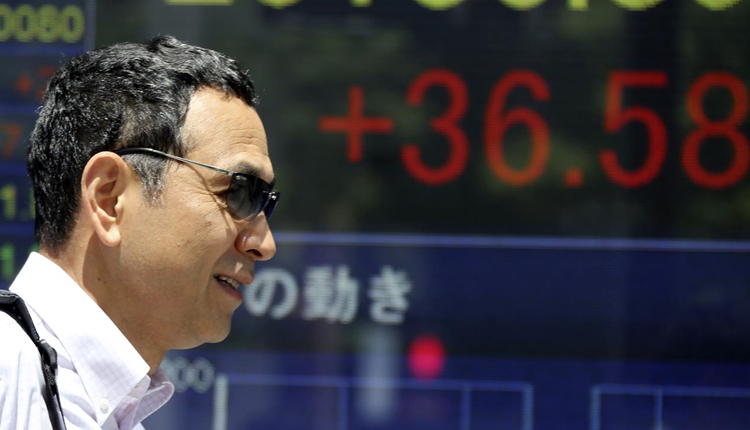Asian stocks saw a broad recovery on Friday following another tumble on Wall Street overnight, with the Dow Jones Industrial Average dropping by more than 500 points.
In the Greater China region, Hong Kong’s Hang Seng index advanced by 2.07 percent in afternoon trade.
Over on the mainland, the Shanghai composite bounced on the back of positive trade data for the month of September to close higher by 0.91 percent at around 2,606.91, while the Shenzhen composite advanced by 0.19 percent at about 1,296.36.
In Japan, the Nikkei 225 saw gains of 0.46 percent to close at 22,694.66 while the Topix index ended largely flat at 1,702.45.
The ASX 200 closed higher by 0.2 percent at 5,895.7 after losing 0.52 percent earlier in the session. The energy sector, however, was lower by 1.5 percent, while the heavily weighted financial subindex was largely flat.
Shares of major banks Down Under saw a recovery though some still ended the trading day lower, with Australia and New Zealand Banking Group down by 0.38 percent while Commonwealth Bank of Australia was largely flat. The move in ANZ’s stock came following an announcement by its chief executive that the bank had fired over 200 staff for wrongdoing.
Over in South Korea, the Kospi saw gains of 1.54 percent at 2,162.37, with shares of chipmaker SK Hynix advancing 5.07 percent.
Wall Street stock rout continues
Overnight on Wall Street, stocks continued to dive for the second straight day. The Dow Jones Industrial Average dropped by 545.91 points to close at 25,052.83, while the S&P 500 fell by 2.1 percent to end the trading day stateside at 2,728.37 — below its 200-day moving average for the first time since April. The Nasdaq Composite also declined by 1.3 percent to close at 7,329.06.
Commenting on the plunge in stocks stateside, U.S. President Donald Trump said on Thursday from the Oval Office: “It’s a correction that I think is caused by the Fed and interest rates.”
Trump said he believes the U.S. central bank’s monetary policy “is far too stringent,” adding that “they’re making a mistake and it’s not right,” and saying he was “not going to fire” Federal Reserve Chairman Jerome Powell.
Echoing Trump’s sentiment on the Fed’s interest rate policy, Richard Bove, chief market strategist at Rafferty Capital Markets, told CNBC on Friday: “The Federal Reserve cannot, you know, set interest rates at such a high level when every other major central bank in the world does not follow.”
“It creates currency problems, inflation problems, interest rate problems and maybe recession problems in other countries and therefore, the flow of funds that was coming to the United States stops and I think that’s what’s happening right now,” Bove said.
White House economic advisor Larry Kudlow also told CNBC on Thursday “there’s some movement” toward a meeting between Trump and Chinese President Xi Jinping in Argentina at the G-20 summit in November, though the talks and topics to be addressed by the two leaders have not “been set in concrete.”
At the same time, the most widely watched measure of investor fear jumped again on Thursday. The CBOE Volatility Index, popularly known as the VIX, gained about 8.8 percent to 24.98 — its highest level since the end of March. The VIX measures implied volatility on S&P 500 index options.
The futures market, however, suggested that a recovery could happen in the next trading session stateside. As of 3:20 a.m. ET, the Dow Jones industrial average futures was up by 303 points, indicating a gain of 430.17 points at Friday’s open. S&P 500 and Nasdaq 100 futures also pointed to solid gains to start off Friday’s session.
Currencies and commodities
The U.S. dollar index, which tracks the greenback against a basket of its peers, was at 94.962 as of 3:31 p.m. HK/SIN, following a slide overnight.
The Japanese yen, often viewed as a safe haven currency, was at 112.34 against the dollar, while the Australian dollar was at $0.7122 after seeing gains yesterday.
In the oil markets, prices saw gains in the afternoon of Asian trade. The global benchmark Brent crude futures contract advanced by 1.27 percent at $81.28 per barrel, while the U.S. crude futures contract gained by 1.17 percent to $71.8 per barrel.
Meanwhile, spot gold declined by 0.39 percent at $1,218.96 per ounce. It had jumped about 2.5 percent on Thursday — its best one-day percentage gain since Jun. 2016 — after marking its highest since Jul. 31 at $1,226.27.
Source: CNBC


